Top News

January 29, 2013 Ryukyu Shimpo
On January 28, the mayors of the municipalities in Okinawa and representatives of the protest rally executive committee visited Prime Minister Shinzo Abe’s official residence to give him a petition requesting that the U.S. and Japanese governments rescind the deployment of the Osprey aircraft and abandon the idea of relocating the facilities at Futenma Air Station somewhere within the prefecture. About 30 people, including Naha Mayor Takeshi Onaga and Nago Mayor Susumu Inamine, were in the delegation. According to Onaga, Abe, who took receipt of the petition which bears the signatures from the mayors of all 41 municipalities in Okinawa and the chairmen of the various assemblies, said, “There are aspects that I need to think about. Lending an ear to the opinion of the Okinawan people as I go, I would like to do my best to ease Okinawa’s burden of hosting U.S. military bases.”
The Okinawan leaders asked Abe to resolve the base issues, telling him that the Okinawa Prefectural Assembly passed a resolution to oppose the deployment of the Osprey and demanded that the relocation of Futenma Air Station be to somewhere outside the prefecture. They also told the Prime Minister that the mayors of all 41 municipalities in Okinawa supported this position. Abe did not specifically refer to the issues of the Osprey or the relocation of Futenma Air Station outside Okinawa.
Onaga talked to the press after the meeting with Abe, saying, “It was significant that Prime Minister Abe took time from his busy schedule to meet us.” Onaga went on to say, “We want the central government to show good faith in its attempts to ease Okinawa’s base-hosting burden.” Chief Cabinet Secretary Yoshihide Suga also attended the meeting.
The mayors and chairmen separated into five groups to visit the Foreign Ministry, Ministry of Defense, Cabinet Office and the U.S. Embassy in Tokyo.
The petition states that the deployment of the accident-prone Osprey aircraft to Okinawa is nothing less than an act of discrimination against the people of Okinawa. It further pointed out that the U.S. military treats the prefecture as occupied territory even though Okinawa has marked the 40th anniversary of its reversion to Japanese sovereignty from U.S. control, and that the base issues are a challenge to the sovereignty of the people in Japan and to the status of Japan as a democratic nation.
Okinawan leaders handed over the petition attached to the paper bearing the signatures of the mayors of all 41 municipalities of Okinawa, the representatives of the Mayor Association, Town and Village Assemblies, Chairman’s Council of the Municipal Assembly, the Chairman’s Council of the Town and Village Assembly, various parties in the Prefectural Assembly, and the rally executive committee.
(English translation by T&CT, Mark Ealey)
Go to Japanese
PETITION
The Okinawa Prefectural Citizens’ Rally Against Osprey Deployment was held on September 9, 2012 to protest with indignation against the forceful deployment of the aircraft and to call for the withdrawal of the deployment plans. More than 100,000 citizens participated in the rally.
However, the governments of Japan and the United States trampled down the collective will of the people of Okinawa and forcefully deployed Osprey planes on October 1, only less than a month after the rally.
Due to the presence of the U.S. Forces’ bases, Okinawa prefecture has been imposed with a multitude of damages related to the military facilities. Looking just at the years since the reversion of Okinawa to Japan in 1972, the number of criminal cases involving U.S. service members, civilians and their family members has reached close to 6,000.
As people of Okinawa have taken every opportunity to explain the situation where incidents, accidents, and noise damage related to the U.S. Forces persist, the Japanese government must be duly aware of the situation. Marine Corps Air Station Futenma, in particular, remains in the middle of a residential area, threatening lives and properties of Okinawan people. The governments of Japan and the United States must be aware that the air station is the most dangerous one in the world.
It is outright discrimination against Okinawans to deploy to the dangerous air station the unsafe Osprey which has had repeated accidents since its development stages and has caused a large number of fatalities. In the continental U.S. and Hawaii, trainings have been suspended after giving consideration to the residents’ concern over noise pollution.
Since the deployment in October and November, during these two months, more than 300 flights violating the Japan-U.S. safety agreement have been witnessed during the observation conducted by the prefecture and municipalities. It makes us believe that the agreement has already failed.
Furthermore, it was revealed that the remaining 12 Osprey aircraft in the U.S. Forces’ plan will be deployed to the MCAS Futenma by July this year. The special operation transport aircraft CV-22 will also be deployed to Kadena Air Base between 2014 and 2016. Such plans are outrageous.
The Ospreys were deployed to Okinawa in the year the prefecture celebrated its 40th anniversary of the reversion to Japan. We hope for the steady progress of Japan as members of the country, while preserving Okinawa’s own history and culture which have been passed on since the time Okinawa was called Ryukyu.
Forty years after the reversion, the U.S. Forces continue to be arrogant as if Okinawa is still under their occupation. Japan’s national sovereignty is being challenged.
Prime Minister Shinzo Abe,
We request you to re-examine the situation of Okinawa and implement measures to realize the united call of its people for alleviation of the burden of hosting the U.S. military bases.
This petition for the below requests is hereby presented by the Executive Committee for the Okinawa Prefectural Citizens’ Rally Against Osprey Deployment, Okinawa Prefectural Assembly, municipalities and municipal assemblies.
1. Immediately revoke the deployment of Osprey and call off the deployment of the additional 12 aircraft slated by July this year. Also, immediately withdraw the plan to deploy the special operation transportation aircraft CV-22 Osprey to Kadena Air Base.
2. Close and remove MCAS Futenma, and renounce the plan to relocate it within the prefecture.
Go to Japanese
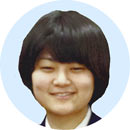
January 23, 2013 Ryukyu Shimpo
On January 17, 19 year-old Rika Chinen from Okinawa Shogaku High School obtained the special-A grade, the highest grade of the United Nations Associations Test of English that requires skills to communicate freely at international conference level.
She said, “I wanted to pass the test while I was at high school, so I am very glad that I managed to do so.”
The test is difficult. Statistics from 2008 to 2010 indicate that successful applicants’ TOEIC score has been 967 and the test includes questions related to relatively difficult subjects, including international affairs. To prepare for the test she exchanged opinions about current affairs with her English teacher in English. In December, when she took the final test in Tokyo it touched upon the Senkaku Islands dispute and the Syrian conflict.
“I made friends with a young Korean when I went to the United States to study and we talked about our views of history. That made me think of working in the United Nations in future.”
(English translation by T&CT, Hitomi Shinzato and Mark Ealey)
Go to Japanese
January 24, 2013 Ryukyu Shimpo
“While they may be modest, we sincerely wish to lead everyday lives that are safe and secure.” So reads the concluding passage of the resolution adopted on January 22 at the Naha citizens rally held to seek the withdrawal of the Osprey aircraft currently deployed to Okinawa. This represents both the highest common denominator in a society and the minimum wish for its people. But have the feelings of the Okinawan people in general, and the citizens of Naha on this occasion, reached the hearts of President Barack Obama and Prime Minister Shinzo Abe?
The mayors of all 41 municipalities in Okinawa are opposed to the deployment of the Osprey aircraft and all the municipal councils have adopted resolutions against it. In an opinion poll carried out in the prefecture approximately 90 percent of respondents are opposed to the deployment of the Osprey. The people of Okinawa view this aircraft, which seems to have no end of crashes, as a threat to their lives and their property.
When Defense Minister Satoshi Morimoto retired at the end of last year, he rejected the military logic of relocating U.S. Marine Corps Futenma Air Station within the prefecture.
We have something that we would like to ask Prime Minister Abe. If this were an issue directly affecting Tokyo, do you think that you would be able to brush off objections and go ahead with a policy if 90 percent of Tokyo’s citizens and all of the mayors of its municipalities were opposed to it? The resolution refers to the unfair treatment by the central government in imposing 74 percent of U.S. military facilities in Japan onto a prefecture that constitutes only 0.6 percent of the country’s land as “discrimination and bullying” of the Okinawan people. It indicates that since the Osprey aircraft were deployed, the U.S. military has not respected the safety measures decided upon in the bilateral agreement between the United States and Japan, and points out that such acts by the U.S. military in Okinawa can only be seen as the approach of those who have an “occupation or colonial mindset.”
The government will not able to gain the understanding of the Okinawan people by imposing further bases on Okinawa. Indeed, in all good conscience, is it not the government and the members of the ruling party who should understand the hardships suffered by Okinawa?
Naha Mayor Takeshi Onaga, the leader of the conservatives in Okinawa and someone who accepts the Japan-U.S. Security Treaty, stated, “Japan imposed the burden of the U.S. bases on Okinawa and enjoyed the rapid economic growth [as a result]. It is unreasonable to think that from now the government can force bases on Okinawa in order to develop the country.”
We would like to pose a question to the governors and people of the other 46 prefectures of Japan. Do you consider the people of Okinawa to be fellow citizens? Is it not best to avoid seeing Okinawa’s excessive burden as someone else’s problem and instead to accept it as a matter that affects you, and strive to think together to try to come up with a solution that matches the feelings of the people of Okinawa? What sort of government or mode of politics ignores citizen’s requests that are delivered through examples of the democratic process such as elections, resolutions of prefectural and municipal assemblies, and the results of opinion polls. Are we seeing the very roots of the nation rot?
Rooted in the reality of having been forced to shoulder an excessive burden, the Okinawan people’s statement of objection is anti-military bases, but it is not anti-American. This is a crucial point that neither government should misread. The Okinawa people have suffered under U.S. military control for 68 years since the war. Looking at the political big picture, the time has come for the government to come up with a solution to the Futenma issue that does rely on relocation within the prefecture. If they cannot achieve this much, Japan and the United States cannot be regarded as true friends of the Okinawan people.
(English translation by T&CT, Mark Ealey)
Go to Japanese
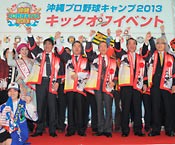
January 25, 2012 Ryukyu Shimpo
On January 24, at Naha Airport, an event organized by the Okinawa Convention and Visitors Bureau and the Okinawa Sports Convention Promotion Association to welcome professional baseball teams to Okinawa was held ahead of their training camps.
This year nine Japanese and six Korean teams will hold their training camps in Okinawa. The total of 15 teams is the largest number to date. Eight teams, including the Hokkaido Nippon-Ham Fighters, the Chunichi Dragons and the Hanshin Tigers will begin their camps from February 2. The Yomiuri Giants start from February 13.
The Hiroshima Toyo Carps usually hold their camp in Okinawa City, but this year they will hold it in Miyazaki Prefecture because the Municipal Baseball Stadium is closed for renovations.
With regard to the Korean clubs, the Hanwha Eagles start from February 20, and other clubs will come from mid-February.
At the Welcome Hall on the second floor of Naha Airport, about 200 people from the various hosting communities and those involved in tourism gathered for the ceremony.
Okinawa Vice Governor Kanetoshi Yoseda gave a speech in which he said, “A tough season is about to start, but I hope that players can prepare themselves well in Okinawa.” Shigenobu Asato, the president of the Okinawa Convention and Visitors Bureau said, “We have been looking forward to the professional baseball camp season for quite some time. We would like to promote Okinawa as a sport-oriented island.”
Buses that will carry people around the various camps of the Japanese teams were also exhibited at the event. During the February period of the professional baseball camp season, on weekdays six buses will operate and seven on weekends and holidays. The prices are 1000 yen for adults and 500 yen for children, and this allows unlimited rides that day.
(English translation by T&CT, Lima Tokumori and Mark Ealey)
Go to Japanese

Go To Video
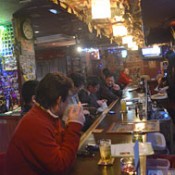
January 23, 2013 Ryukyu Shimpo
In the evening of January 19, around Gate Street in downtown Koza, eight men from inside and outside of Okinawa participated in a night tour called “American Story in Koza.” Guided by Takahiro Kina from the Koza Information Center, they went around restaurants and music venues, sampling the nightlife of Koza.
They enjoyed something to eat at American Pizzaman at Central Park Avenue before moving on to Gate Street. They pinned a U.S. dollar bill with their name on it on the ceiling in the oldest A-sign pub Prince on the street, enjoying a different culture. At the last spot on the tour, Club Queen, they took in a live performance by the Filipino band Prism.
One of the people on the tour said, “I haven’t had a chance to visit Koza before because it was not included in our school trip.” Another person hopes to come back with his family at some stage. Takahiro Iwasaki from Tokyo seemed happy to have discovered a new aspect of Okinawa.
For more information about the Night Tour, call Okinawa Champuru Expo Planning Committee at 098 (987) 9606.
(English translation by T&CT, Megumi Chibana and Mark Ealey)
Go to Japanese
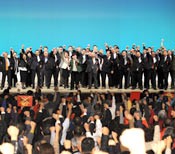
January 23, 2013 Ryukyu Shimpo
In the afternoon on January 22, Okinawan leaders held a rally at the Naha Civic Hall to request that the U.S. and Japanese governments rescind the deployment of the Osprey to Okinawa.
About 1300 people participated in the rally. They criticized the U.S. and Japanese governments for forcing through deployment of the Osprey to Okinawa, saying, “The deployment is a reckless act that serves to further humiliate the Okinawan people who have already suffered the excessive burden of hosting the U.S. military since the end of World War II.” The participants adopted the resolution unanimously, asserting that the deployment of the Osprey represents discrimination against and bullying of the Okinawan people and therefore cannot be ignored.
Representatives of the rally will send the resolution statement to the authorities related to the U.S. and Japanese governments. The U.S. and Japanese governments deployed the Osprey to Okinawa last year just three weeks after a protest rally against the deployment held on September 9, 2012 attracted more than 100000 participants. About this, Naha Mayor Takeshi Onaga, who represented the organizers, said, “That protest attracted such a large number of participants for a good reason. The central government just dismisses Okinawan people’s protest out of hand.” Onaga said that he will continue to request that the U.S. and Japanese governments rescind the Osprey deployment, and will oppose the relocation of Futenma Air Station within Okinawa. He said, “Japan enjoyed rapid economic growth by forcing Okinawa to bear the burden of hosting the bulk of the U.S. military presence in Japan. It is unreasonable for the central government to talk about developing the Japanese economy while continuing to impose such a burden on the people of Okinawa.” Based on the fact that the members of the Naha City Assembly have resolved to oppose the Osprey deployment a total of four times, Seiko Nagayama, the chairman of the assembly, said, “We cannot ignore the current situation we have in which the U.S. and Japanese governments treat Okinawan people with derision.”
With regard to Prime Minister Shinzo Abe’s book entitled Towards a Beautiful Country: My Vision for Japan, Haruo Mekari, the head of the Community Promotion Council of the Naha Corporation of Labor, said, “We would like you to include Okinawa in your vision of a beautiful country, and to rescind the Osprey deployment to help unlock the future of Okinawa.”
Onaga talked to the press after the rally, saying, “Applause just went on and on. I strongly sense their determination in requesting that the U.S. and Japanese governments rescind the deployment of the Osprey. I am confident that the Okinawan people’s voices will be more broadly heard by those living in the main islands of Japan.” Onaga renewed his pledge that he and other representatives will convey the Okinawan people’s will to oppose the Osprey deployment to the central government in Tokyo on January 27 and 28.
(English translation by T&CT, Mark Ealey)
Go to Japanese

Go To Video
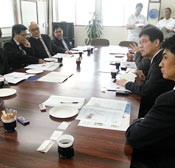
January 17, 2013 Ryukyu Shimpo
The Okinawa Flour Milling Co. is expanding its business in Asia for the first time. They will be selling a flour and brown sugar powder mix in Hong Kong and Taiwan this year. On January 16, CEO Ichiro Takeuchi said that he can see an end ahead for expansion of market share in Okinawa because the prefecture’s population will reach its peak. He said, “We cannot compete on price in Tokyo, but we can try to actively expand into overseas markets. Exporting Okinawan products will bring financial gain, and that means that we will not need to rely on revenue from U.S. military bases.”
In September 2012, Okinawa Flour Milling participated in the largest food exhibition in Asia – the Food Expo in Hong Kong. At first, they had hoped to attract interest from the general public, but unexpectedly it turned out that there was more interest for professional-use. In December they also took part in the Bakery Expo. Takeuchi went to Hong Kong and checked out the level of marketability overseas. In October, they also participated in the Food Expo in Taiwan.
“Business happens very quickly overseas. There were companies that wanted to set up deals then and there. Japanese flour is rated higher In Asia than we had expected. If we ship it to Tokyo, we have to compete on price, but if we have to spend money on transport costs, I would rather invest in potential markets in Asia, such as the Indian market,” said Takeuchi, expressing an interest in expanding beyond Hong Kong and Taiwan.
On January 16, Okinawa Flour Milling showed their flour and brown sugar mix to senior management members from the major sugar sales company, Taikoo Sugar from Hong Kong. Okinawa Flour Milling representatives told the visitors, who were visiting Okinawa to purchase sugar, that deep-fried donuts can be shipped using chilled transportation.
Taikoo Sugar has an affiliate company that handles airline food catering services for Cathay Pacific Airways. They showed interests in items such as bread made with the brown sugar flour mix, which could be used in in-flight meals. Penny Wang, the director of the company, was impressed with the chewy texture of the Pão de Q mix donuts, and asked whether or not the amount of sugar in the mix can be adjusted.
(English translation by T&CT, Kyoko Tadaoka and Mark Ealey)
Go to Japanese
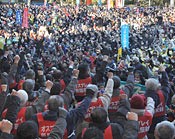
January 28, 2013 Ryukyu Shimpo
On January 27, the mayors or representatives of all 41 municipalities in Okinawa, the head of the Okinawa Prefectural Assembly and representatives of the rally executive committee went to Tokyo to participate in the rally held at the Hibiya Open-Air Concert Hall. The objective of the rally was to request to the U.S. and Japanese governments that the deployment of the MV-22 Osprey vertical take-off and landing transport aircraft to U.S. Marine Corps Futenma Air Station be rescinded. About 4000 people are reported to have participated in the rally.

At 3:43pm on January 27, in the Hibiya Open-Air Concert Hall in Tokyo, participants from Okinawa, including the heads of municipalities, raised their fists in the air as they made their demands.
Comments such as “We want the people of the main islands of Japan to share the burden of hosting the U.S. military bases,” and “All the citizens of Japan should take part in discussions on Japan-U.S. security arrangements,” were heard from among the participants.
This is one of the largest rallies held by Okinawan people in Tokyo in the years since the prefecture’s reversion to Japanese sovereignty. On January 28, the mayors handed a petition to Defense Minister Itsunori Onodera, Foreign Minister Fumio Kishida, other related ministers, and representatives of other political parties to request that the U.S. and Japanese governments rescind the deployment of the Osprey and abandon the idea of relocating the facilities at Futenma Air Station within the prefecture. (Links to footage of the rally are on the website. Please refer to the links at the end of this article).
Masaharu Kina, the chairman of the Okinawa Prefectural Assembly and co-leader of the committee gave the opening speech at the rally. Naha Mayor Takeshi Onaga, Toshiyasu Shiroma, the head of the Town and Village Assembly, and Seiko Nagayama, the head of the Chairman’s Council of the Municipal Assembly, and Masaru Nakamura, the head of the Chairman’s Council of the Town and Village Assembly also spoke.
Kina said, “The deployment of the Osprey forces Okinawans to bear a greater burden in order to strengthen the functions of U.S. bases. This is something that could possibly put citizens, including children, in danger.”
Onaga stated that the Okinawan people’s anger had come to the boil in response to the U.S. and Japanese governments having forced through deployment of the Osprey. Referring to “Restore Japan,” the catchphrase used by Prime Minister Shinzo Abe in the last Lower House election, Onaga said, “You cannot restore Japan by continuing to place the burden of Japanese security only on Okinawa. All the people in the main islands of Japan need to take part in discussion on Japan-U.S. security agreements.”
Shiroma said, “We would like all of Japan’s citizens to share the pain that Okinawa endures.” Nagayama said, “We want the central government to provide peace and safety for Okinawa.” Nakamura said, “The U.S. military conducts training for Osprey crews without adhering to the protocols on this agreed upon by both nations. We want the U.S. military to remove the Osprey from Okinawa as soon as possible.” As a display of commitment Nobumasa Nakamura, the chairman of the Rengo Okinawa and co-leader of the committee, wrapped up the rally by shouting “Ganbaro!” (Let’s keep up the struggle!) three times.
In addition to the representatives from Okinawa, members of Okinawan associations in the main islands of Japan, students and other citizens, members of various citizen groups also participated in the rally. The Ryukyu Shimpo newspaper also issued a special edition to commemorate the rally.
After the rally, to continue their protest against the deployment, participants marched about two kilometers through Ginza and other places.
(English translation by T&CT, Mark Ealey)
Footage of the protest rally
1: The first half of the rally
2: The last half of the rally
3: The parade after the rally (edited)
Go to Japanese

Go To Video
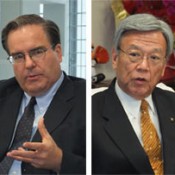
January 17, 2013 Ryukyu Shimpo
In the afternoon of January 16, at the Naha Municipal Office, the U.S. Consul-General in Okinawa Alfred R. Magleby met Naha Mayor Takeshi Onaga in order to apologize for the series of crimes that U.S. servicemen committed at the end of last year.
The consul-general apologized for causing troubles for Naha citizens. In response, the mayor stated that the Japan-U.S. Status-of-Forces Agreement needs to be reviewed and that the Naha Military Port should be returned at an early stage, saying, “We cannot establish good relations as neighbors without resolving these fundamental issues.”
This is the first time that the U.S. consul-general has come to apologize to the mayor of Naha for such a sequence of incidents. Up until now, when U.S. soldiers committed crimes, local chief executives would visit the Office of the Consulate General of the United States to protest, but last November Onaga suggested that the U.S. consul-general should come to the Naha Municipal Office to explain and apologize. Magleby said that some people here may view less serious crimes as being worse than they are, and stressed that most U.S. servicemen and women are fine young people.
In response, the mayor remarked that Okinawa is overburdened with U.S. military bases and suffers from crime committed by U.S. military personnel. He was critical that the U.S. military only provides newcomers with one month of orientation programs about Okinawa, and that the U.S. government does not return the land it seized in Okinawa. “This clearly indicates that the United States looks down on Okinawa,” said Onaga. The mayor pointed out that Okinawa has had to experience many very difficult things since WWII. He said that regardless of how the U.S. government apologizes in future, it will be difficult to accept such apologies without a review of the Japan-U.S. Status-of-Forces Agreement.
The mayor asked the consul-general, “Why do you think Okinawans are angry?” The consul-general answered that he could understand Okinawan people’s feelings, and that it might be a result of history. The mayor remarked that Naha Military Port remains unused and requested its early return. The consul-general commented that the port has existed for emergency situations and that the U.S. military will fully utilize the facilities when and if such a situation arises.
(English translation by T&CT, Lima Tokumori and Mark Ealey)
Go to Japanese
January 20, 2013 Hideki Matsudo of Ryukyu Shimpo reports from Washington D.C.
On January 17, a five-gallon bucket fell from an USMC MV-22 Osprey vertical take-off and landing transport aircraft and smashed through the roof of an auto repair shop near the Miramar Marine Corps Air Station in San Diego, damaging six vehicles. According to former chief analyst Arthur Rex Rivolo, the Osprey lacks a pressure adjustment function, so it flies with its rear hatch open to get a clear rear view. Rivolo said that if the aircraft flies without its crew and cargo being firmly strapped in, they could fall out. NBC News and XETV-TV, which cover the San Diego California area, reported the incident. No one was injured.
According to a representative of MCAS Miramar, the bucket was tied down with rope, but at some point it came loose and fell from the door or rear hatch of the MV-22 Osprey. This occurred at about 7:00pm, immediately after the aircraft took off. The bucket containing cleaning solution crashed through the roof of an auto repair shop near the marine base, damaging several vehicles. Officials of the MCAS are investigating the accident. Employees discovered a hole in the roof on the morning of January 17. The bucket broke apart upon impact, damaging several vehicles and spilling cleaning solution on others. It was confirmed that the liquid was not dangerous.
A local truck driver said, “It could just have dropped right out here on one of our trucks out here while we were working. So it was close.”
There was an accident in Afghanistan in 2011 involving an Osprey flying with its rear hatch open. On that occasion crew members were killed when they fell from the rear of an aircraft flying at 60 meters. Rivolo said that although the Osprey flies with its rear hatch open, normally the crew and cargo are firmly strapped in, but this time that was not done, so Rivolo pointed out that the accident was caused by human error.
(English translation by T&CT, Mark Ealey)
Go to Japanese

January 13, 2013 Ryukyu Shimpo
On January 12, Karakara, a movie jointly produced by Japan and Canada and shot entirely on the islands of Okinawa by Claude Gagnon, was released at Cinema Q in Naha and Mihama 7 Plex in Chatan. Director Claude Gagnon, leading actress Yuki Kudo and producer Takako Miyahira gave speeches at both cinemas in Okinawa. At the Montreal World Film Festival 2012 the movie received the Audience Award and the Special Openness to the World Award. It will be released nationwide on January 19.
Yuki Kudo said, “We would like people to understand that the message of this movie that it is never too late to start afresh in our lives. This message coming from Okinawa means that it rings true. We are really pleased to be able to convey this from Okinawa.” Director Claude Gagnon said, “Right from the start, this movie was filmed with people in Okinawa. I want it to be Okinawa’s movie and for it to be a vehicle to showcase Okinawa to the world.” Yukito Ara who wrote the songs used in the movie, and Isamu Shimoji, who created and sings the theme song, also commented on the movie.
(English translation by T&CT, Hitomi Shinzato and Mark Ealey)
Go to Japanese

Go To Video














 Webcam(Kokusai Street)
Webcam(Kokusai Street)


